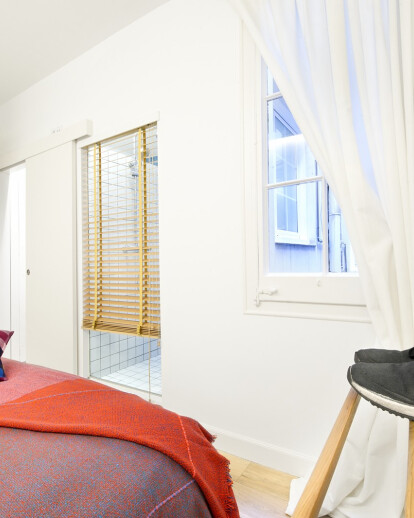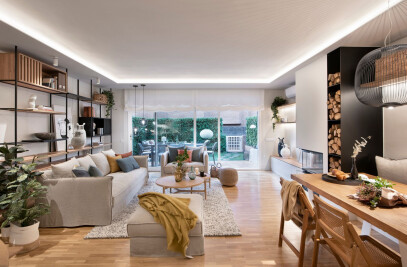Can the layout of a house be improved by eliminating unnecessary partitions while maintaining the original number of rooms?
Can you spatially communicate contiguous (public and private) spaces without affecting the privacy of the tenants?
Can you justapose various textures and finishes while maintaining a “light” visual atmosphere. One such that would work as blank canvas ready to receive the decorative contributions of future inhabitants of the space?
The renovation project of the housing unit in Sant Joan gives a convincing answer to all the above questions. And its result, comparable to an endless number of examples due to its typology and similar dimensions, confirms that design and the experience of the interior architects, are not at all incompatible with tight budgets or smaller homes. The initial briefing of the project consisted of: 1.- Maintain current value of housing in terms of number of rooms, considering the possibility of future re-selling; 2. Achieving a much more attractive lay out in terms of space distribution and lighting; 3.- Bluring the boundaries of the corridor, integrating it to the whole while making it the star architectural element as a communicator and a “livable” space. Additionally we wanted to optimize itineraries, and wean those most public of the most private.
Thus, the design process began by dividing the house into two separate realms: one private and one public. Exchanging for this purpose, the locations of the kitchen, bathroom and dressing rooms. The master´s bedroom in its new location, adjacent to the bathroom and dressing room, offered the possibility of accessing these rooms through and independent route, making of this bedroom what is commonly referred to as "en suite". Meanwhile the relocated kitchen, opened naturally to the social area through a corridor and widened access.
This social area, in the main façade “wing” of the house, revolves around a large wooden table that separates the three subareas located here: the study area, the dining room and the lounge. Over this table a pendant lamp claims the attention, running along a top rail that allows it to move and adapt to different uses while hanging from a ceiling of Catalan vault of restored wooden beams. In the background, a brick wall, bathed in dimmable indirect light, recalls the historical and architectural heritage of this listed building, while relating harmoniously with the original pavements of traditional hydraulic tile, reclaimed and polished to give them new life and aesthetic validity. Above it , a Persian rug is arranged as a means of unobtrusive spatial boundary that defines a living room space that looks over the magnificent Passeig de St. Joan of Barcelona through two superb balconies.
Just steps away from the dining area, and without the interposition of doors or walls, the kitchen is found. This room, which previously used to be private and technical, now proposes a close visual relationship with the dining room, benefiting from all the light that washes over the main facade while annexing to the its limited space those few square meters occupied by the hall. The small bar, approachable from both sides, blurs the frontiers between the two spaces, and the signature photograph on the opposite wall manages to deepen the perspective and give continuity to the proposed style. The kitchen, more and more, a gathering place for families where not only the mother cooks, or where those who cook no longer do it strictly on their own, is now home to many different activities: Here, of course we cook, but here we also eat, wash the clothing, read the newspaper, browse our “ipads”, work, have a drink with friends, along with a very extensive etcetera. The fact that the client can now do all this in a well lit open space with views, is one of the greatest achievements of this project.
The Master´s Bedroom, in its new "en suite" status poses not only a possibility of private access to the bathroom and dressing room, but also invites an "intimate" visual relationship between the shower and bedroom realms. Separated only by a glass wall and a Venetian wooden shutter, it allows light to enter as well as an intimacy / sensuality play between both areas. In this bedroom, of neutral aesthetic, the headboard wall stands out, covered with a stunning "pixelated" graphic by designer Cristian Zuzunaga. The bathroom is divided into two sub spaces in order to improve its performance: in the front portion two sinks (one for each of the owners) are found installed over generous marble vanity tops , while at the back, the most intimate portion of the bathroom houses the toilet and shower sanitary ware furniture. Following the formal discourse linked to the shape of the pixel applied in the bedroom, here the white and turquoise color tiles were broken down to a format of 10x10cm. All in all, the stylistic renewal and spatial redistribution of the property have undertaken opposite chronological trajectories. The first wandered back in time to find historical references in the architectural past, while the second tried to reflect current lifestyles and future necessities, always gaining in each case, natural light for each stay, a greater feeling of general spaciousness and an exponential increase in the range of uses of the unit as a whole.
If the house of your dreams invites you look to into the future while remembering the history; if it entices you to use the space in more than one way; or if it welcomes your guests, while it feels intimate and exclusive to you, this house in Sant Joan could be yours: Egue y Seta and your designers.

































